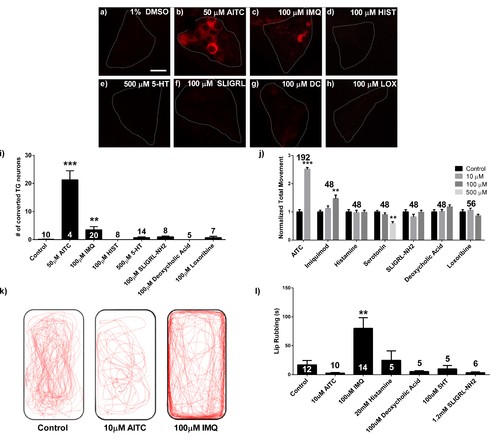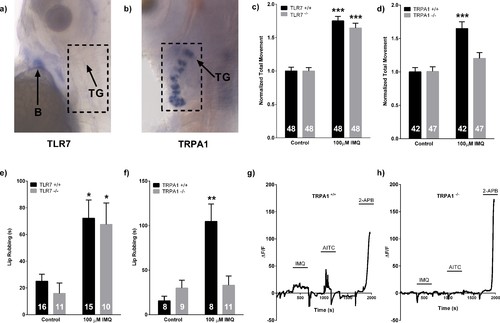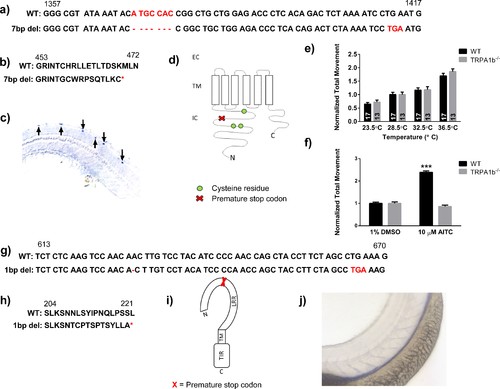- Title
-
A zebrafish and mouse model for selective pruritus via direct activation of TRPA1
- Authors
- Esancy, K., Condon, L., Feng, J., Kimball, C., Curtright, A., Dhaka, A.
- Source
- Full text @ Elife
|
Imiquimod produces behavioral and neuronal responses in the zebrafish. (A?H) 3dpf live elavl3:CaMPARI TG imaging of larvae exposed to 405 nm light and control (A), 50 ?M allyl isothiocyanate (AITC) (B), 100 ?M imiquimod (IMQ) (C), 100 ?M histamine (HIST) (D), 500 ?M serotonin (5-HT) (E), 100 ?M SLIGRL-NH2 (F), 100 ?M deoxycholic acid (DCA) (G), and 100 ?M loxoribine (LOX) solutions (H). (I), Counts of photoconverted cells from experiments (A-H). (J), 5dpf WT larval locomotor behavior screen. (K) Representative traces of adult behavior. (L) Adult lip-rubbing behavioral assay. (I, J, L) ***p<0.001, **p<0.01, one-way ANOVA. Bars represent mean ± s.e.m. EXPRESSION / LABELING:
PHENOTYPE:
|
|
Trpa1b, but not Tlr7, is required for both neuronal and behavioral responses to IMQ. (A, B) In situ hybridization in 3dpf WT larvae probing for tlr7 and trpa1b mRNA respectively. (C, D) Larval locomotor assay of 5dpf tlr7+/+ and tlr7-/- (C) or trpa1b+/+ and trpa1b-/- (D) larvae. (E, F) Adult lip-rubbing behavioral assay of tlr7+/+/tlr7-/- (E) and trpa1b+/+/trpa1b-/-(F) fish. (C), (D), (E), (F), 100 ?M IMQ used. ***p<0.001, **p<0.01, Student?s t-test. Bars represent mean ± s.e.m. (G, H) Representative calcium imaging traces of 3dpf trpa1b+/+ (G) and trpa1b-/- (H) larvae in a transgenic elavl3HuC:GCaMP5 background exposed to 100 ?M IMQ, 50 ?M AITC, and 1 mM 2-APB. B = blood, TG = trigeminal ganglion. EXPRESSION / LABELING:
PHENOTYPE:
|
|
TRPA1b and TLR7 nonsense mutations in the zebrafish. (A) The 7 bp deletion in the trpa1b coding sequence generated a premature stop codon at 1412 bp. (B) Amino acid sequences of the WT and mutant Trpa1b proteins. (C) In situ hybridization probing for trpa1b mRNA in WT 3dpf larval zebrafish, demonstrating expression in RB neurons. (D) Schematic of the Trpa1b protein structure, demonstrating that a truncated protein (in the unlikely event that it was translated) would lack a critical cysteine residue required for agonist binding (Macpherson et al., 2007). (E) Trpa1b-/- nonsense mutants locomoted more in response to increasing temperatures at levels equivalent to their WT/heterozygous siblings. (F) Normal AITC behavioral responses (increased locomotion) are abolished in trpa1b-/- nonsense mutants. (G) The 1 bp deletion in the tlr7 coding sequence generated a premature stop codon at bp 665. (H) Amino acid sequences of WT and mutant Tlr7 proteins. (I) Schematic of the Tlr7 protein, demonstrating that a truncated protein (in the unlikely event of translation) would lack critical functional domains. (J) In situ hybridization probing for tlr7 mRNA in WT 3dpf larval zebrafish. No tlr7 expression was observed in RB somatosensory neurons. Premature stops are denoted with red highlighting. EC = extracellular, IC = intracellular, TM = transmembrane domain, LRR = leucine rich repeat, TIR = Toll Interleukin-1 Resistance domain. C and N denote c- and n-termini. (E), Student?s t-test. EXPRESSION / LABELING:
|



